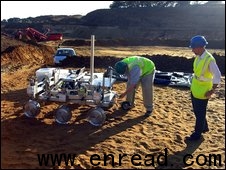| ||||||||||||||||||||||||||||||||||||||||||||||||||||||||||||||||||||||||||||||||||||||||||||||||||||||||||||||||||||||||||||||||||||||||||||||||||||||||
|
a 1 in the south of england has been the site of an "eye test" for europe's planned rover mission exomars. 英国南部一座采石场被作为欧洲火星计划漂流者exomars进行“视力测试”的地方。  the quarry - chosen for its similarity to martian 2(地带,地域) - saw cameras and image processing software tested on the exomars prototype(原型) rover bridget. the rover will be equipped with a raft of(许多) cameras and the aim is to integrate(综合,统一) them and the data they will send back. the technology developed for the mission has applications not only in space science but also here on earth. the 3 rover will have a pair of front-mounted navigation cameras and a quartet(四重奏) of cameras at its corners for hazard(冒险,危害) avoidance. it will also have a pair of scientific cameras that give it stereoscopic vision(立体视觉) and thus depth perception, as well as a high-resolution camera for 4 in on areas of interest. the wide-angle scientific cameras are equipped with filter wheels, which limit the light that reaches them to specific 5. measuring the sunlight reflected off martian terrain in these specific bands gives information on the chemical 6 of whatever is in the field of view. the aim of the eu provisg (planetary robotics vision ground processing) project is to stitch(针脚,缝线) together all of the information from the cameras, ensuring for example that the scientific results are tagged to the location at which they were taken and that the navigation cameras' views are assembled into a virtual, 3d representation of the rover's environment. also at issue is how to get that data sent back to earth; there is a finite amount of information the rover will be able to send back in a day. what is more, the data's trip from mars can take 20 minutes, so for mission-critical movements, it is important to be able to bounce data and instructions back and 7 as quickly as possible. as a result, the cameras' resolution has been 8(故意地) limited so that the image files they send back are not too unwieldy(笨重的,笨拙的), and part of the project concerns itself with compacting and minimising the total amount of data the rover must send. qualifications while much of the technology to acquire images, send them 9, and stitch them into a sensible whole already exists, getting similar systems onto the surface of mars is a whole different matter. "imagine you have a terrestrial(地球的,地上的), state-of-the-art computer. we couldn't send it into space because it would never survive," said lester waugh, lead engineer for eads astrium, the space firm that led the development of bridget and 10 the uk efforts of provisg. he explained that anything sent to mars has to withstand(抵抗,对抗) the extreme 11 of launch, space temperature extremes of both hot and cold, and constant bombardment(轰击,撞击) from cosmic rays. engineering around those 12 and then testing equipment to 13 standards - making it "space 14" - takes a great deal of time, so space-worthy technology necessarily lags behind the less 15(强壮的,强健的) terrestrial version. the project is also concerned with developing tools to display and make use of the data from the rover. "from the images, we can generate 3d 16(海拔,提高) maps - 3d representations that you can actually explore," dr waugh explained. "once you've created that model you can use all the surface 17 you've gained from the imagery, and you've got an environment that people can go and explore. you can become almost like a field 18, in the field on mars." the new visualisation tools can also be used to inform future, manned missions to mars. "it's a bit like google street view: you can go down to street level and explore the environment so that when you drive into the place, you know what's going on there. "it's the same for astronauts - if you want them to know what the environment is like, then give them a 3d virtual reality experience. this helps a lot with their planning." for more earth-based applications, dr waugh said that robust imaging technology developed for exomars could see use in rovers used for 19 science or in nuclear sites, where temperature and radiation extremes limit typical robotic technology. he added that the 3d visualisation approaches could be "great fun" if used for gaming. 点击  收听单词发音 收听单词发音
|
||||||||||||||||||||||||||||||||||||||||||||||||||||||||||||||||||||||||||||||||||||||||||||||||||||||||||||||||||||||||||||||||||||||||||||||||||||||||
- 发表评论
-
- 最新评论 进入详细评论页>>

